"The Master", a new film in 65mm by Paul Thomas Anderson |
Read more at in70mm.com The 70mm Newsletter |
| Written by: The Weinstein Publicity department | Date:
27.09.2012 Updated: 21.12.2023 |
Synopsis | |
 A
striking portrait of drifters and seekers in post World War II America, Paul
Thomas Anderson’s "The Master" unfolds the journey of a Naval
veteran, Freddie (Joaquin Phoenix), who arrives home from war unsettled and
uncertain of his future until he is tantalized by The Cause and its
charismatic leader, Lancaster Dodd (Philip Seymour Hoffman). Amy Adams plays
Dodd’s wife, Peggy. A
striking portrait of drifters and seekers in post World War II America, Paul
Thomas Anderson’s "The Master" unfolds the journey of a Naval
veteran, Freddie (Joaquin Phoenix), who arrives home from war unsettled and
uncertain of his future until he is tantalized by The Cause and its
charismatic leader, Lancaster Dodd (Philip Seymour Hoffman). Amy Adams plays
Dodd’s wife, Peggy.• Go to "The Master" production notes (PDF) |
More in 70mm reading: "The Master" production notes (PDF) P T Anderson's "The Master" in System 65 Motion pictures photographed in Super Panavision 70 & Panavision System 65 Now showing in 70mm in a theatre near you! |
About the Editing | |
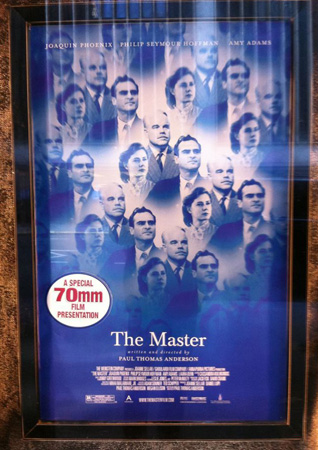 Poster
decoration in New York taken 25. September 2012 Picture: Sebastian Roascker Poster
decoration in New York taken 25. September 2012 Picture: Sebastian RoasckerThough THE MASTER is wholly fictional, Paul Thomas Anderson set out to present the world of The Cause with a visceral and transporting realism. To capture both authentic period details and the imagined environs of The Cause on sea and land, he worked with a devoted crew, many of whom have forged a kind of family of their own, reuniting again and again on his productions. One major, if entirely intuitive, decision immediately set the film off on a very individual course: Anderson’s choice to shoot THE MASTER with the now exceedingly rare 65mm film stock. From the start, he knew he wanted a distinctive period look – and after immersing himself in the vibrant tones and textures of such 50s cinematic classics as VERTIGO and NORTH BY NORTHWEST, Anderson hoped to mirror that supersaturated lushness, merging it with his own signature style of stark lyricism. With imagery spanning from the roaring sea to the shadows and light at play within the characters, 65mm seemed a perfect match for the broad contours of the story. There was a time when 65mm stood at the very apex of cinematic processes, but today it has been relegated mostly to the making of IMAX® and other large-format films. In the heyday of Hollywood’s wide-screen epics, companies such as Todd-AO and Panavision hailed 65mm as giving audiences the crispest, clearest images, from the most panoramic vistas to the most personal close-ups. Numerous 60s classics including LAWRENCE OF ARABIA, WEST SIDE STORY, MUTINY ON THE BOUNTY, LORD JIM, MY FAIR LADY and 2001: A SPACE ODDYSEY revealed the power of the film stock to deliver that ineffable extra punch of vitality. But by the 1970s the increasingly high cost of the film stock caused a rapid decline. A brief resurgence in the 1980s saw such films as BRAINSTORM, TRON and THE BLACK AULDRON reviving the format, but that was short lived. More recently, the only films shot entirely on 65mm have been Kenneth Branagh’s 1996 HAMLET and Ron Fricke’s non-narrative films BARAKA and SAMSARA. (Christopher Nolan’s INCEPTION and THE DARK KNIGHT and Terrence Malick’s THE NEW WORLD include some 65mm footage and special effects sequences, but were shot primarily in 35mm.) Anderson says the choice started as an exploration, but became a commitment once he saw the fit with the storytelling of THE MASTER. “The idea was something initially suggested by Dan Sasaki, Panavision's lens technician, after I'd inquired about Vista Vision Cameras from the 8 50s, just to play around with and figure out how some of these 50s films created their look,” he explains. |
|
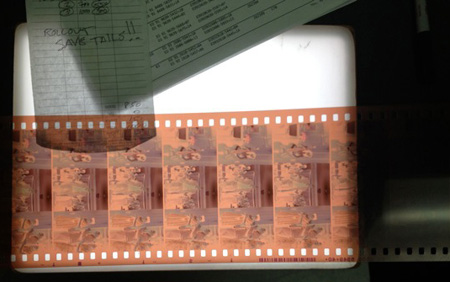 A
strip of 65mm negative from "The Master". Image by Paul T Anderson, and made
available for in70mm.com by Cigarettes and Red Wines web site A
strip of 65mm negative from "The Master". Image by Paul T Anderson, and made
available for in70mm.com by Cigarettes and Red Wines web siteHe goes on: “We started shooting with a 65mm Studio Camera and everything we were seeing started to feel very right. It gives you a wonderful, strong image, but more than the resolution or anything like that, it simply seemed to suit this story and these characters. Things could feel antique without feeling precious or a re-enactment of a particular style. It’s hard for me to describe it other than to say, it felt right.” JoAnne Sellar felt similarly. “It was so fitting for a film like this with so much visual texture,” she says. “But it was also a real learning process because a lot of the knowledge of working with 65mm has been lost. There were considerable challenges involved. We were only able to find three Panavision cameras, so it was challenging when they broke down, and the lab process is also very complicated.” Daniel Lupi adds: “Panavision went totally out of their way to service us in using cameras that have largely gone unused for decades. At times we had a guy from Panavision staying with us, just so he could handle technical issues with the cameras.” Throughout filming, Anderson would project the dailies using a 65mm projector as well. “I think it’s a large of his creative process, watching the dailies and conforming his vision to that,” explains Lupi. “He has a very organic process.” The filmmakers are gratified that some audiences will get a chance to see the film in 70mm projection. “In an ideal world, audiences can enjoy the film in 70mm. There are still theaters playing 70mm films, thank goodness. Long may they wave,” says Anderson. |
|
About the Editing | |
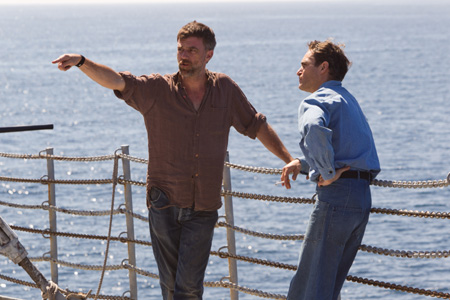 As
principal photography of THE MASTER came to a close, Anderson worked with
editors Leslie Jones and Peter McNulty to weave the imagery with his
distinctive rhythms and pacing. McNulty did a first cut and then Jones, who
previously received an ACE nomination for her work on Anderson’s PUNCH-DRUNK
LOVE, came on board. She was taken right away with the footage. As
principal photography of THE MASTER came to a close, Anderson worked with
editors Leslie Jones and Peter McNulty to weave the imagery with his
distinctive rhythms and pacing. McNulty did a first cut and then Jones, who
previously received an ACE nomination for her work on Anderson’s PUNCH-DRUNK
LOVE, came on board. She was taken right away with the footage.“Peter did a beautiful first cut of the film and I was impressed with the complexity in both Freddie and Master's characters as well as the depth in their relationship. I was surprised at how the love story between these two men so gracefully became the focus of the film,” she comments. She spent the next six months working closely with Anderson to chisel the final narrative. “The primary challenge in editing was to focus the relationship between Freddie and Master, and to connect Master's teachings with the struggles that Freddie experiences in his life – his experience of always running from something,” Jones explains. “We found ultimately that the more invested we were in Freddie’s experience the more we believe his attraction and need for a ‘Master.’ And, at a certain point, it became less about the characters as individuals but more about these two men and their attachment to one another.” While the 65mm photography had no impact on the editing, it became a distinct challenge as the release prints were prepared. Jones explains: “I rarely made a distinction between the two formats while viewing the footage. Nor were editing considerations made based on the 65mm format. It wasn't until picture was locked and we began working with Fotokem on release prints that we felt the impact. We had to prepare the finished film for both a 70mm and 35mm release, which was like working on two separate movies. And because Paul likes to do a film finish we were cutting negative and timing photo chemically, so it was very time consuming.” Nevertheless, concludes JoAnne Sellar: “For all the complications of using 65mm, I think for Paul it was well worth it. It’s an attempt at saving the beauty of real film.” |
|
Paul Thomas Anderson about 65mm | |
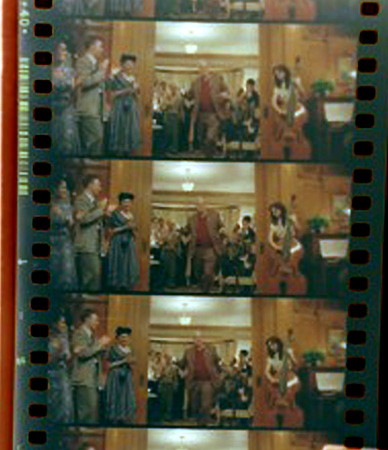 65mm
negative clip from "The Master" - reversed to positive. Image by
Paul T Anderson, and made
available for in70mm.com by Cigarettes and Red Wines web site 65mm
negative clip from "The Master" - reversed to positive. Image by
Paul T Anderson, and made
available for in70mm.com by Cigarettes and Red Wines web siteQuestion: Your choice to film in 65mm, appropriate to the period, obviously. Does it matter if your audience doesn't see that, because presumably only a minority of the audience are going to see it in 70mmn Paul Thomas Anderson: Yes, no, I mean, does it matter? If you are in that kind of thing, you'll probably love it. You know, you’ll be able to feel a slight difference if you know, but it's ultimately No. I mean, listen, I've loved movies I've watched on my phone, I hate to say, and I loved moves I've seen in theatres I mean, it's a hard thing now a days, and hopefully, you know, the people that loved to go to movie theatres, loved to go movie theatres, and we kind of hopefully presented this option, that if you wanna dig it this way, it's there for you. I prefer it. I enjoy it. I think it's a more well balanced meal, just in terms of the way that it kinda comes through the projector and the light and umm, and things moving around, and..... I prefer it. But certainly does not mean you are not gonna like the movie if you have to see it in any other way. It also doesn’t mean you gonna like it any more Question: Can't imagine what “The Master” would be like on a phone Paul Thomas Andersson: [Laughs] Actually no, hopefully not too bad. Shouldn't matter, I mean, I remember like seeing, like these guys, like hovered around in a garage watching "Saving Private Ryan" on this like little teeny black and white TV, and these guys were just loving the film in a parking garage in South America, and they were completely in to it. They didn’t need it on a big screen, they didn’t need whatever HiFi sound and all that. They are just digging the film |
|
"The Master" 70mm Cast & Credits | |
|
Written
and Directed by Paul Thomas Anderson. Exec. Producer:
Adam Somner, Ted Schipper. Producer:
Paul Thomas Anderson, JoAnne Sellar, Daniel Lupi, Megan Ellison. Co-producers: Albert Chi, Will Weiske. Production Co.:
Annapurna Pictures. Screenplay:
Paul Thomas Anderson. Cinematographer: Mihai Malaimare, Jr. Editor:
Leslie Jones, Peter McNulty. Sound:
Michael Semanick, Christopher Scarabosio, Matthew Wood, Mark Ulano. Music:
Jonny Greenwood. Prod. Designer:
Jack Fisk, David Crank. U.S. Distributor:
The Weinstein Company. Music supervisor, Linda Cohen; Set designer: John P. Goldsmith;
Set
decorator, Amy Wells; Costume designer: Mark Bridges; Sound (Dolby Digital/Datasat),
Mark Ulano; Supervising sound editors, Christopher Scarabosio, Matthew Wood;
Sound designer, Scarabosio; Re-recording mixers, Michael Semanick,
Scarabosio; special effects coordinator, Michael Lantieri; senior visual
effects supervisor, Dan Glass; visual effects supervisor, Gregory Liegey;
visual effects producer, Andy Foster; visual effects, Method Studios;
stunt
coordinator, Garrett Warren; assistant director, Adam Somner; casting,
Cassandra Kulukundis. Filmed in: 65mm, 5 perforations, 24 frames per second. Principal photography in: Panavision System 65. Presented in: Panavision Super 70 in selected theatres with _._ track Datasat _-track digital stereo. Aspect ratio: 1,85:1. "The Master" was shot with a Panaflex System 65 Studio Camera. It was framed for 1.85:1. 80% of the finished film is in 65mm. The remaining 20% is shot in standard 35mm. The reason for using both film formats was a creative choice. The 65mm film stock used was Kodak 5201 (50ASA) Country of origin: USA. Production year: 2012 World Premiere: 01.09.2012, Venice Film Festival, Italy. US premiere: 14.09.2012, Los Angeles and New York. A Weinstein Co. release and presentation of a Joanne Sellar/Ghoulardi Film Co./Annapurna Pictures production. Freddie Quell - Joaquin Phoenix Lancaster Dodd - Philip Seymour Hoffman Peggy Dodd - Amy Adams Helen Sullivan - Laura Dern Variety reviewed the film at Venice Film Festival, Sept. 1, 2012. (Also in Toronto Film Festival -- Special Presentations.) MPAA Rating: R. Running time: 136 min. |
|
Soundtrack | |
 CD Tracklist CD Tracklist01 Overtones 02 Time Hole 03 Back Beyond 04 Get Thee Behind Me Satan – Ella Fitzgerald 05 Alethia 06 Don’t Sit Under the Apple Tree (With Anyone Else but Me) – Madisen Beaty 07 Atomic Healer 08 Able-Bodied Seamen 09 The Split Saber 10 Baton Sparks 11. No Other Love – Jo Stafford 12 His Master’s Voice 13 Application 45 Version 1 14 Changing Partners – Helen Forrest |
|
"The Master" Premiere | |
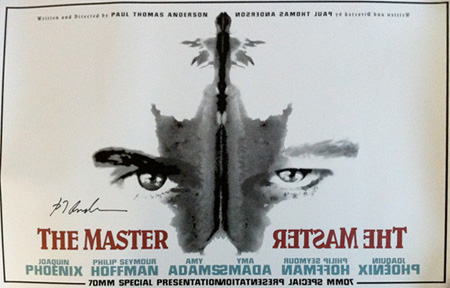 "The
Master" advert from San Francisco 70mm screening (August 2012) showing a 70mm strap line "The
Master" advert from San Francisco 70mm screening (August 2012) showing a 70mm strap line
U.S. |
|
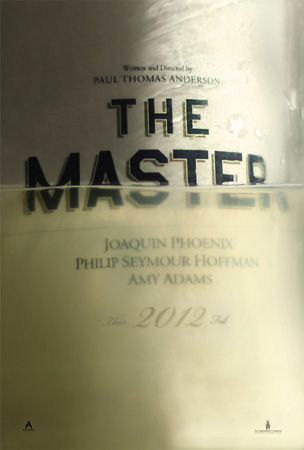 US
1-sheet poster Style #1 US
1-sheet poster Style #1Limited 70mm Premiere 14.09.2012 9/14 AMC Loews Lincoln Square 12 (70mm) 9/14 City Cinemas Village East Cinemas (70mm) 9/14 ArcLight Hollywood (2x 70mm prints including Cinerama Dome) 9/14 Landmark Los Angeles (70mm) Wider 70mm Premiere 21.09.2012 9/21 Austin, Alamo Ritz (70mm) 9/21 Boston, Kendall Square Cinema, Coolidge Corner Theatre (70mm) 9/21 AFI Silver Theatre Silver Spring, MD (70mm) 9/21 Seattle Cinerama, Seattle, WA (70mm) 9/21 The Grand Lake Theatre in Oakland CA, USA (70mm) 9/21 New York, The Ziegfeld (70mm) 9/21 New York, Cinema 1 (70mm) 9/21 Cineplex Odeon Varisty Cinema, Toronto, Canada (70mm) Germany 05.10.2012 Festival screening 8. Todd-AO 70mm-Festival |
|
 US
1-sheet poster #2 US
1-sheet poster #2Even wider 35mm Premiere 21.09.2012 9/21 Chicago 9/21 San Francisco, Embarcadero Center Cinema 9/21 Baltimore, The Charles Theatre 9/21 Washington DC, Landmark E Street Cinema, Bethesda Row 9/21 Philadelphia, The Ritz Five 9/21 Cleveland, Cedar Lee Theatre 9/21 Omaha, Film Streams |
|
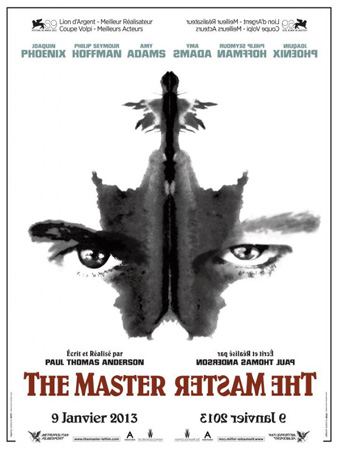 70mm Poster adapted for the French Market 70mm Poster adapted for the French MarketInternational Italy 1 September 2012 (Venice Film Festival) 70MM Canada 7 September 2012 (Toronto International Film Festival) 70MM USA 14 September 2012 (limited) 70MM Canada 21 September 2012 (Toronto) 70MM USA 21 September 2012 Canada 28 September 2012 Israel 4 October 2012 Germany 7 October 2012 (Todd-AO 70mm Film Festival, Karlsruhe) 70MM Australia 25 October 2012 (Melbourne) (premiere) 70MM Ireland 2 November 2012 Mexico 3 November 2012 (Morelia International Film Festival) Australia 8 November 2012 70MM Turkey 9 November 2012 Poland 14 November 2012 (Wroclaw American Film Festival) Poland 16 November 2012 UK 16 November 2012 70MM Sweden 17 November 2012 (Stockholm International Film Festival) Greece 6 December 2012 Italy 3 January 2013 Spain 4 January 2013 France 9 January 2013 70MM Iceland 11 January 2013 New Zealand 17 January 2013 Netherlands 23 January 2013 (International Film Festival Rotterdam) 70MM Netherlands 24 January 2013 70MM Singapore 24 January 2013 Brazil 25 January 2013 Denmark 31 January 2013 70MM (from 13 February) - print #5, came from Finland Sweden 1 February 2013 Portugal 7 February 2013 Argentina 14 February 2013 Russia 14 February 2013 Norway 15 February 2013 Chile 21 February 2013 Germany 21 February 2013 Hong Kong 21 February 2013 Belgium 6 March 2013 Japan 22 March 2013 |
|
| Go: back - top - back issues - news index Updated 22-01-25 |
